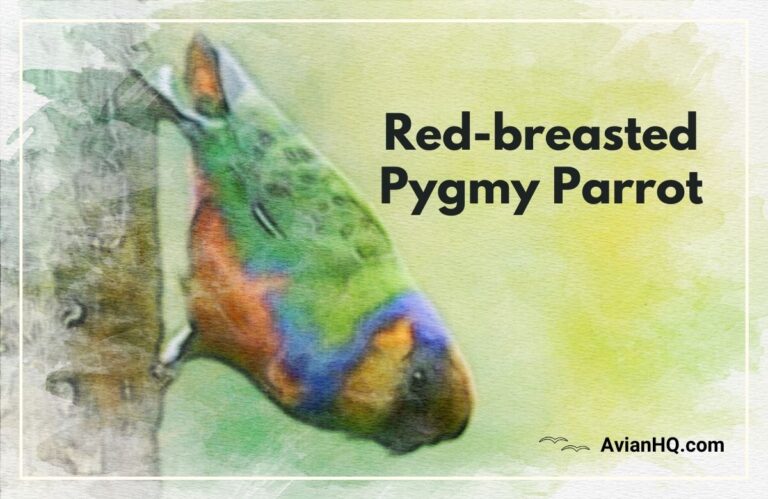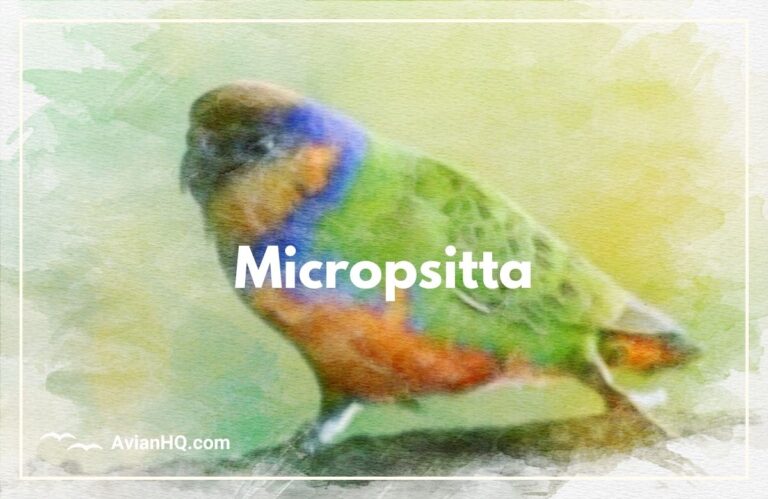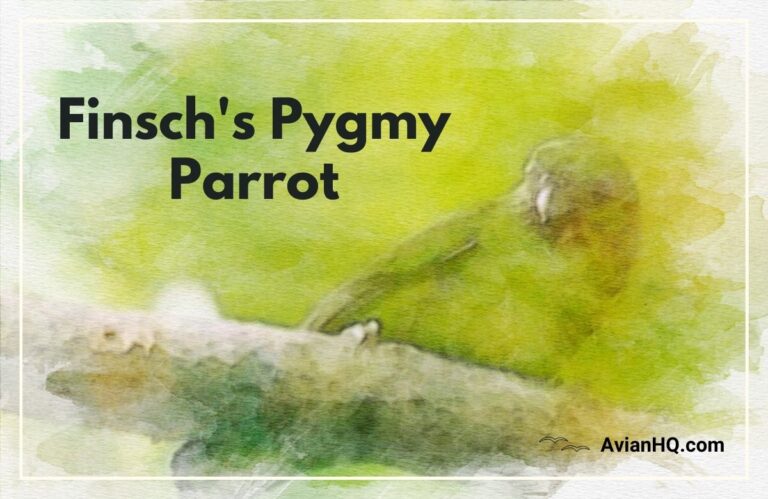Yellow-capped Pygmy Parrot (Micropsitta keiensis)
The yellow-capped pygmy parrot (Micropsitta keiensis) is a tiny, vibrantly colored parrot native to New Guinea and it’s surrounding islands. Though small, it packs a lot of personality into it’s bright green, yellow, and blue plumage.
These parrots reach only 9-10 cm in length but are brimming with energy and curiosity. They actively forage for fruit, seeds, insects, and more while clambering acrobatically through the forest canopy. Their high-pitched squeaks ring through the trees as they chatter and call to one another.
Despite their beauty, yellow-capped pygmy parrots are not well known outside of New Guinea. Their remote island habitats have made them less accessible to scientific study. However, researchers are beginning to uncover more about the ecology and behaviors of these diminutive parrots.
In this article, you’ll learn all about the identification, distribution, diet, reproduction, and conservation status of the yellow-capped pygmy parrot. Read on to meet this pint-sized rainforest acrobat!
Some key details to know:
- Found in forests of New Guinea and nearby islands
- Weighs only 11-14 g
- Recognizable by the yellow crown and green body
- Nests in tree cavities and termite mounds
- Feeds on fruit, seeds, lichen, insects
- Three subspecies with slightly different plumage
History and Taxonomy of the Yellow-capped Pygmy Parrot
The yellow-capped pygmy parrot was first described scientifically in 1867 by German ornithologist Gustav Hartlaub. it’s scientific name Micropsitta keiensis refers to it’s tiny size (micro meaning small, psitta meaning parrot) and it’s presence on the Kei Islands of Indonesia where it was originally collected.
Hartlaub assigned it to the new genus Micropsitta due to it’s diminutive stature compared to other parrots, which measure 13 inches (33 cm) on average. The yellow-capped pygmy parrot reaches only 3.7 inches (9.5 cm) in length.
Today, three subspecies of the yellow-capped pygmy parrot are recognized:
- M. k. keiensis – Occurs on the Kai and Aru Islands
- M. k. viridipectus – Ranges across southern New Guinea
- M. k. chloroxantha – Found on the Vogelkop Peninsula and western Papuan islands
The subspecies differ slightly in their plumage. M. k. viridipectus is darker overall than M. k. keiensis. Male M. k. chloroxantha have orange-red breast feathers that the other subspecies lack.
Over the decades since it’s discovery, the yellow-capped pygmy parrot has perplexed taxonomists due to it’s intermediate morphology between genera. More research is still needed to uncover the exact evolutionary relationships between Micropsitta and related parrot groups.
Physical Appearance of the Yellow-capped Pygmy Parrot
The yellow-capped pygmy parrot is aptly named for the vibrant yellow cap on it’s crown. This pale yellow plumage covers the forehead and crown, shading to an olive-green on the hindcrown and nape.
The rest of the body is primarily green in color. The upperparts and wings are a parrot green, while the underparts are a more yellow-tinged green. The face is olive-brown, which gradually transitions into the green on the cheeks.
Other standout markings include the blue central tail feathers and the yellow undertail coverts. The tail feathers on the outer edges are greenish-black. The eyes are brown and the bill is gray.
Overall, the yellow-capped pygmy parrot reaches 3.7 inches (9.5 cm) in length and weighs just 0.4-0.5 oz (11-14 grams). Compared to other parrot species, it is quite tiny.
The three subspecies show some subtle differences in coloration:
- M. k. viridipectus is darker green overall than M. k. keiensis.
- Male M. k. chloroxantha have orange-red feathers on the breast and belly, while females lack this bright color.
- Juveniles of M. k. keiensis are duller in color than adults until their plumage matures.
The yellow-crowned pygmy parrot is somewhat similar in appearance to the red-breasted pygmy parrot. However, the latter has a red cap instead of yellow.
Habitat and Distribution of the Yellow-capped Pygmy Parrot
The yellow-capped pygmy parrot is endemic to the island of New Guinea and surrounding smaller islands. it’s range stretches across western New Guinea including the Vogelkop and Onin Peninsulas.
It is also found on several satellite islands near New Guinea:
- Kai Islands
- Aru Islands
- Gebe Island
- Waigeo Island
- Salawati Island
- Misool Island
This species inhabits lowland forests up to an elevation of 1,800 ft (550 m). Some of it’s preferred habitats include:
- Lowland rainforests
- Mangrove forests
- Swamp forests
- Secondary forest regrowth
- Coconut groves
It may also forage in trees around rural villages and gardens. However, it is generally restricted to forested areas and not found in open country.
Within it’s forested habitat, the yellow-capped pygmy parrot usually forages in the dense understory layer. But it will ascend into the mid-canopy and upper canopy to feed and nest.
No introduced populations of this parrot species exist beyond it’s native islands. it’s remote island distribution has prevented natural colonization or human-assisted introductions to new regions.
Diet and Feeding Habits of the Yellow-capped Pygmy Parrot
The yellow-capped pygmy parrot is a generalist feeder that consumes a wide variety of plant material and small insects.
Fruit and seeds make up the bulk of it’s diet. It forages for berries, figs, and other soft fruits. Small nut and seed specimens are also eaten.
This parrot supplements it’s fruit/seed diet with protein sources like insects and insect larvae. It will capture tiny insects while clambering through foliage.
Additionally, yellow-capped pygmy parrots feed on lichen, algae, and fungi growing on the bark and leaves of trees. Their small beaks allow them to scrape up these growths.
Foraging takes place while working through all vertical layers of the rainforest canopy. These parrots often hang upside-down to pick at food sources. The bill is used to pluck, peel, and grip food bits.
Yellow-capped pygmy parrots may forage alone but are also seen in pairs or small flocks. When feeding socially, they keep in contact with quiet squeaks and chirps.
This species spends 50-60% of daylight hours searching for and consuming food. Their high metabolism requires frequent nourishment.
In captivity, the diet consists of a nutritious parrot seed mix, chopped fruits/veggies, greens, and protein sources. Mealworms and crickets provide an appropriate insect protein substitute.
Breeding and Reproduction of the Yellow-capped Pygmy Parrot
The breeding season of the yellow-capped pygmy parrot extends from September through March annually. During this period, pairs will construct nests and lay clutches of eggs.
Nest sites are typically located 3-13 feet (1-4 meters) above ground. Two main nesting sites are utilized:
- Tree Hollows – Existing cavities in living or dead trees are adopted and enlarged.
- Arboreal Termite Nests – The parrots will excavate a chamber in a termite mound nest located high in a tree.
The clutch size is usually 2 white eggs which are incubated by both parents. The incubation period is unknown but, probably lasts around 3-4 weeks.
Once hatched, the altricial chicks are cared for by both parents. They are fed regurgitated food frequently to fuel growth. Chicks fledge at roughly 5-6 weeks old and reach independence a few weeks later.
Based on limited data, it appears yellow-capped pygmy parrots may be monogamous and mate for life. However, more study is needed on wild pairs.
In captivity, breeding success has been limited. Only a few zoos and private keepers have managed to hatch chicks. Providing proper nest sites helps induce breeding behavior.
Behavior and Ecology of the Yellow-capped Pygmy Parrot
The yellow-capped pygmy parrot is an energetic, acrobatic species that spends much of it’s time clambering through rainforest vegetation. It forages actively throughout all layers of the canopy.
These parrots may be seen alone, in pairs, or in small flocks of 5-10 birds. Pairs likely represent mated couples, while flocks are temporary aggregations.
Roosting takes place in natural tree cavities or old nest sites. Groups of adults and juveniles may pile into a well-used roost tree hollow.
Vocalizations include high-pitched squeaks, chirps, and chatters. Mated birds engage in contact calls to maintain their bond. Predator alarm calls consist of abrupt, urgent squawking.
Though small, yellow-capped pygmy parrots are bold and curious. They will readily investigate new food sources and objects. However, they remain wary of potential threats while occupied with foraging.
These parrots may interact or even forage alongside other bird species. Documented relationships with other New Guinea endemics like fruit doves exist.
With a broad habitat range and varied diet, the yellow-capped pygmy parrot has adapted well to the island’s ecology. Future study of it’s behavioral patterns and relationships can further reveal it’s niche.
Conservation Status of the Yellow-capped Pygmy Parrot
The yellow-capped pygmy parrot is evaluated as Least Concern on the IUCN Red List of Threatened Species. it’s population appears stable and is not considered globally threatened.
However, no quantitative data exists on it’s total population numbers in the wild. Surveys are needed to establish a population estimate across it’s range.
There are no major widespread threats to the species currently known. Localized habitat loss from logging and agriculture represents a minor concern.
The yellow-capped pygmy parrot is listed on Appendix II of CITES, restricting international trade. Capture for the pet trade is limited since few reach aviculture.
Across it’s island habitats, the pygmy parrot remains relatively common. It adapts readily to some habitat disturbance and secondary forest growth.
Conservation priorities include surveys to estimate population size, continued habitat protection, and management of sustainable harvesting.
With an expanding human footprint on New Guinea, it will be important to monitor yellow-capped pygmy parrot populations for any declines. But at present, this diminutive parrot remains a thriving endemic of the island’s forests.
Cultural Significance of the Yellow-capped Pygmy Parrot
The yellow-capped pygmy parrot features in the indigenous art and folklore of some New Guinean cultures.
For example, it appears carved into ceremonial poles and masks created by communities in Papua New Guinea. it’s bright colors and diminutive stature have made it a subject of fascination.
These tiny parrots have sometimes been captured for pets by local peoples. Their compact size and curious nature can make them appealing companion birds, though they are less commonly kept than larger parrot species.
However, extensive trapping for the pet trade is not believed to have occurred. The island’s isolated geography limits access for international collectors.
More in-depth anthropological study is needed on the significance and uses of this species to native societies across New Guinea. There are likely rich cultural traditions still unrecorded.
Conclusion
The yellow-capped pygmy parrot is a charming and acrobatic rainforest bird endemic to New Guinea and it’s surrounding islands. Though small in stature, it represents a unique component of the region’s biodiversity.
This parrot inhabits a diversity of lowland forest habitats up to 1,800 feet in elevation. It forages actively for fruit, seeds, insects, fungi and more while clambering through the canopy.
Distinctive yellow plumage crowns the head, contrasting with green upperparts and yellowish underparts. Blue central tail feathers provide a dash of extra color.
Researchers still have much to uncover about the ecology and behavior of the yellow-capped pygmy parrot. As one of New Guinea’s lesser-studied endemics, it merits further field study and observation.
While not considered globally threatened, continued habitat conservation is important for this species across it’s island home. Surveying populations will also establish a baseline for future monitoring.
The yellow-capped pygmy parrot adds a lively splash of color and activity to the forests of New Guinea. Protecting it’s arboreal habitat will ensure this tiny acrobat continues dazzling ornithologists for decades to come.







